I’m not sure how Luzine Happel does it, but she has an uncanny way of making me want to drop everything in my stitching world and devote my life to Schwalm Whitework. Luzine is the author of what I call THE (that’s pronounced “thee”) definitive guide to Schwalm whitework embroidery, called Basic Principles of Schwalm Whitework. Her first self-published book on Schwalm embroidery is absolutely a must-have if you have any interest in this type of whitework.
Then she did it again, publishing a book of step-by-step instruction for Fancy Hems used for Schwalm embroidery and any other techniques where you’d like to employ a fancy hem in your embroidery. And then she published books of fillings – fillings, fillings, and more fillings to use for whitework.
And doggonit. She’s gone and done it again! Her new book is called Early Schwalm Whitework: described in great detail and illustrated with step by step instructions, or just Early Schwalm Whitework for short.
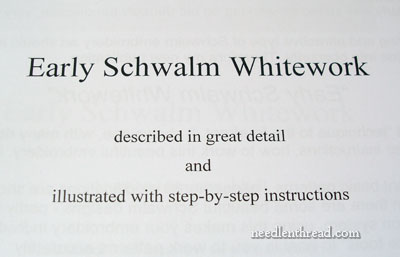
For Lovers of All Things Schwalm, this book is going to twitterpate you. But even if you are not a Schwalm fan or a whitework fan, this book can help you tremendously in your surface embroidery pursuits. When I first started through the book, I was burning to take up Schwalm for life. When I finished the book, I was itching to pick up colored wools, silks, cottons and you-name-it, and put the techniques in the book to work in color.
I know! I know! It’s the Great Schwalm Transgression, the notion of working Schwalm in color. But this is the thing: I love it when a book on one technique opens up so many possibilities for other embroidery techniques as well.
If you stick with me, I’ll explain what I mean.
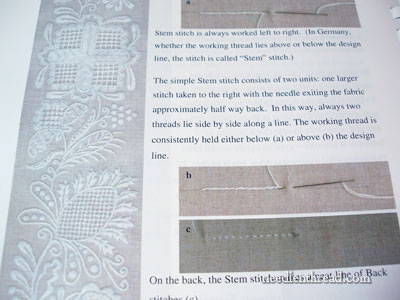
First of all, what’s the difference between Schwalm whitework as we know it today, and “early” Schwalm whitework? Luzine explains this in the book, but all you really have to do is study the beautiful examples of early Schwalm in the book to see the great differences. See, Schwalm as we know it today came about at the beginning of the 1800’s, but “early” Schwalm had been developing since the mid 1700’s. The visible differences include a lack of coral knot stitch for outlining, an abundance of stem stitch outlines, a lack of drawn thread and pulled thread fillings, and an abundance of surface stitch fillings that are really beautiful.
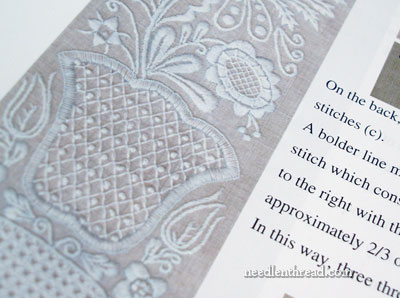
You can see here a little close a piece of embroidery demonstrating typical early Schwalm fillings and outlines.
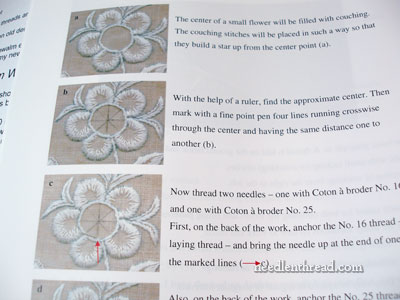
Typical of Luzine’s books, she takes the reader step-by-step through the techniques using photos and text for explanation.
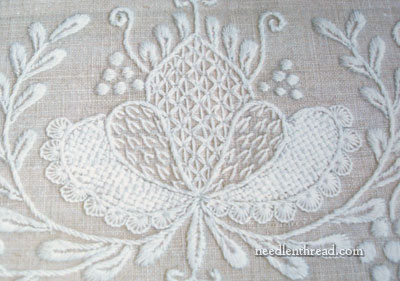
You’ll enjoy many clear photos of finished pieces illustrating the techniques discussed in the book, too.
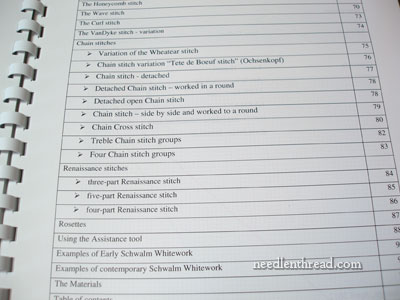
She has an excellent index in the back of the book, for looking up the various stitches and techniques.
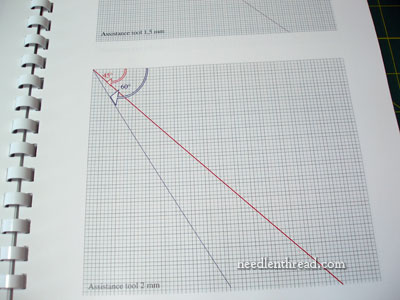
There’s a section of graphs where you can practice working out design elements, fillings, lattices created at different angles, and so forth.
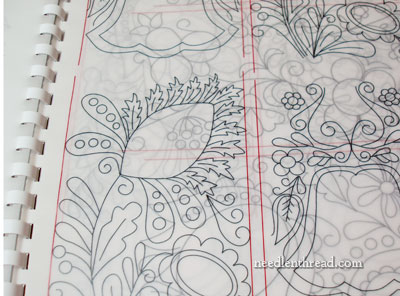
And she piles the icing on the cake pretty high with an excellent array of ready-to-use patterns. The pattern elements can be used individually as practice pieces or they can be strung together for borders for tablecloths, tea cloths, table runners, pillowcases, you name it. The patterns are printed on one side on a heavy vellum, so they are see-through, which makes it easier to trace them.
Now, this is what I was talking about earlier: all the techniques in this book can be adapted to different types of surface embroidery. They aren’t just Schwalm techniques. There are some fantastic fillings in here, for example, that would be beautiful worked in colored wools for crewel embroidery. And the instruction in the book carries over to any kind of surface embroidery instruction – after all, stem stitch is stem stitch, and satin stitch is satin stitch. So while the book explores early Schwalm whitework and lays out clear instructions for the techniques used in early Schwalm whitework so that you can imitate this look in your own whitework projects, you can actually use this book for all kinds of embroidery applications. Even the patterns are suitable for regular surface embroidery.
Early Schwalm Whitework is another wonderful book by Luzine Happel! If you want to add it to your library, visit Luzine’s website and use the “contact” link (“Kontakt”) in the footer of the site. On the contact page, you’ll find her e-mail address. You can send inquiries directly to her, and she’ll get back to you. Normally, she e-mails a Paypal invoice to anyone who wants to purchase her books. She fills orders quite quickly and is a pleasure to work with.
Whew. Now the question is: how do I get this new bug for Schwalm out of my system so I can get back to what I’m supposed to be doing?!







The only way to deal with a craving is to give in to it. Do some Schwalm, then get on with what you are supposed to be doing.
OOOHHHHH, AAAAHHHHH. I’m with you it DOES make you want to drop what you’re doing and jump in to Schwalm world!
Beautiful; it is indeed enticing. May have to check this out!
Your glowing review of Luzine Happel’s books is absolutely correct. I received my copy of her newest book plus two others a couple of weeks ago. Since I live in the USA, Luzine translated the price from Euros to dollars for me to make using Paypal easier. The books arrived within two weeks.
Also, I admit that I have done Schwalm on a dark linen fabric and used variegated thread. This design is on a purse I made a few years ago. I backed the fabric with a lighter one when making the purse. Of course the intricacy of the pulled thread work doesn’t show up as well as it would on white. However,the overall result is still lovely.
There is something so striking to me about white on white or white on linen. I really like that she provides graphs for practicing and dont forget the frosting. The best part of the cake is frosting! How I love predawn patterns. I can see how these could be used for bright crewel work pieces too. Oh how I adore embroidery (blissful sigh)….
I can certainly see why her book would make you want to stop everything and pick up the whitework! Great review!
Mary,
I’m with you, I want to sit and stitch on a beautiful Schwalm table cloth all day instead of finish my hanky quilt blocks or contiue to work on my cross stitch. I didn’t know what it was called, but I adore Schwalm whitework. I am going to find a way to use it even if I just make myself a couple of new pillows. Thanks for sharing this great resource. Now I guess Imust return to my current project.
Finally took the plunge and sent an e-mail to Luzine. Thanks to your reviews, and after purchasing some Schwalm books that didn’t “do it for me” I decided that it is worth the money if the book can give me the direction I desire.
Regards,
Doreen from Maine
Dear Mary
You exuberance is very catching and I’ve purchased one Luzine’s Schwalm book, only to realise I liked the fillings better in another of her books. So thank you for reminding me, I’ll check out her webpage. By the way, “twitterpate” – I think you’ve coined a new word!!
Hi Mary,
If you were to pick one book of Luzine’s to learn Schwalm Embroidery, which one would you recommend. All of her books look great. I have never tried Schwalm and would love to give it a go.
Tania
Hi, Tania – definitely Basic Principles. It’s a wonderful “starter”! -MC
Mary,
I am currently stitching a project from Luzine’s “Basic Principles of Schwlam Whitework” for left hander. You are absolutly correct in your description of how clearly Luzine’s books are written. It is easy to be successful while learning, as the photos and text explain everything so well. I have become fascinated with Schwalm Whitework, since working on this project. I will indeed be adding this book to my library.
I am not sure I want to know your cure for ignoring your urge to Schwalm, as I plan to keep on Schwalming!
Deb
‘Twitterpate’ – what a fantabulous word. Do you mind if I use it?
Can you tell me the difference between Schwalm and Whitework please? There seem to be several examples of white-on-white embroidery and I know next to nothing about any of them, so your help would be very gratefully received.
Thank you.
Ek het alreeds in engels gevra waar en hoe e die boeke kan bekom. ek stel in altwee belang, groot asseblief. ons moet schwalm werk doen vir ‘n kompetisie